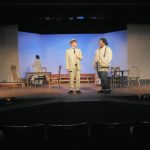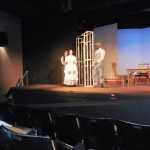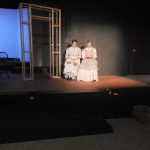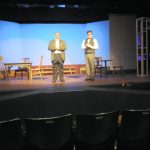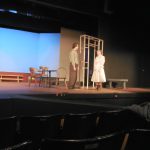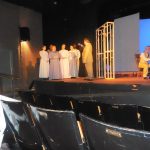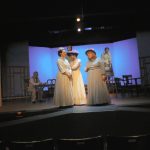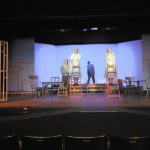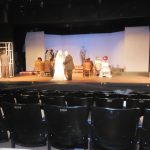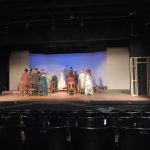Players Visit Our Town
Community Players will kick off a new decade by presenting one of the greatest American dramas: Thornton Wilder’s Our Town.
When Our Town opened at Henry Miller’s Theater on Broadway on February 4, 1938, it shook the foundations of the American theater. At the time, realism dominated the Broadway stage, with set designs that sought to replicate the living rooms, parlors, or gardens in which the action was set and with acting that respected the so-called fourth wall; that is, the actors never acknowledged the presence of the audience, fostering the illusion that the spectators were observing something that was really happening. Wilder eschewed realistic sets, instead using chairs, tables, and step ladders to represent the environment in which the characters lived. Moreover, he incorporated a narrator figure, the Stage Manager, who directly addresses the audience, introduces the setting and the characters, sometimes plays characters himself, and generally acknowledges the artificiality of the whole proceeding.
The story of Our Town is in one sense simple. It is set in the small town of Grover’s Corners, New Hampshire, in the first years of the twentieth century. The focus is on two families, the Webb and the Gibbs families, as they go about the mundane aspects of everyday life: reading the paper, cooking meals, chopping wood, doing homework, celebrating birthdays. In these seemingly simple things, however, reside the profundities of life, love, and death. Wilder’s genius lay in revealing the big ideas that we tend to be blind to as we focus on the trivialities of the day-to-day.
The original production starred Frank Craven as the Stage Manager and Martha Scott as Emily Webb (with Teresa Wright as her understudy) and won the Pulitzer Prize for Drama. (Wilder also won Pulitzers in 1928 for his novel The Bridge of San Luis Rey and in 1943 for his play The Skin of Our Teeth.) In the 1940 film adaptation, Craven and Scott reprised their roles and were joined by young William Holden as George Gibbs.
Our Town has been produced around the world and has frequently returned to the New York stage. In 1944 it was revived at the New York City Center with playwright Marc Connelly as the Stage Manager, Martha Scott again as Emily, and Montgomery Clift as George. A 1969 production starred Henry Fonda as the Stage Manager and featured Ed Begley, Margaret Hamilton, Mildred Natwick, and John Beal. In 1988 the Lincoln Center Theater presented a revival with Spalding Gray as the Stage Manager, Penelope Ann Miller as Emily, and Eric Stoltz as George. A 2002 revival marked Paul Newman’s return to Broadway as the Stage Manager. Finally, an Off-Broadway production in 2009, directed by and starring David Cromer as the Stage Manager, ran for 644 performances, the longest run for any production of the play.
In addition to the 1940 film, Our Town has frequently been adapted to other media. The 1988 and 2002 Broadway revivals were both filmed for television, and in 1977 a TV version starring Hal Holbrook was broadcast. In 1955 a musical adaptation, with songs by Sammy Cahn and Jimmy Van Heusen, was aired as part of Producers’ Showcase. It starred Frank Sinatra as the Stage Manager, Paul Newman as George, and Eva Maire Saint as Emily. It was in this production that Sinatra introduced his hit song “Love and Marriage.” A stage musical adaptation called Grover’s Corners, by Tom Jones and Harvey Schmidt (of The Fantasticks fame), has had several regional productions, but has never played New York. In 2006 an opera adaptation by Ned Rorem premiered at the Lake George Opera in upstate New York and has since been sung elsewhere. To inspire so many productions and adaptations, Wilder’s story clearly speaks to something in all of us.
Director Marcia Weiss has assembled and honed a fine cast for Community Players’ production our Our Town.
Dakota McDaniels is smooth and confident as the stage manager. (Mr. McDaniels is quickly reaching stalwart status at Community Players. Our Town is the third production in the last two seasons in which he has had featured roles.)
Much of the action of Our Town features two families: The Gibbses and the Webbs. Scott Meyers portrays Dr. Gibbs, and Jen Maloy plays his wife Julia. Their children are played by Allen Van Luvender as George and Morgan Rondinelli as Rebecca. The venerable Bruce Parrish plays town editor Charles Webb and Lynda Rettick portrays his wife Myrtle. Their children are played by Anna Sheltens as Emily and Tyler Grey-Henry as Wally.
Other townsfolk include Anthony Overton as milkman Howie Newsome, Jackson Thorpe as newspaperboy Joe Crowell, Jared Cantrell as Professor Willard, Jason Cook as choir director Simon Stimson, Martha Smith as Louella Soames, Lolu Jimoh as Constable Warren, Matt Bushue as Si Crowell, Tom England as Sam Craig, Theosha Lowe as Joe Stoddard’s widow, and Joe Culpepper as Farmer McCarty. Filling out the ensemble are Cris Embree, Jim Kalmbach, Opal Virtue, Britni Williams, and Mary Ann Manos. Several of the production staff also appear on stage in various roles.
Members of the creative staff include Judy Stroh as producer and Samantha Smith as dramaturge; Kathy Parrish is in charge of properties, Ashleigh Feger is stage manager, Joanne Howard is house manager, and Cris Embree is music consultant.
The set, designed by Chris Terven and built by Terven and Bruce Parrish, is intentionally minimal. The Gibbs’ and Webbs’ dining rooms consist simply of dining tables and chairs stage right and stage left, respectively. Ladders are used to represent the Webbs’ and Gibbs’ second floors. Main Street, as pointed out to the audience by the stage manager, is a raised platform upstage which also serves as the church’s altar. Properties are also minimal with actors pantomiming much of the action. The costume design by Opal Virtue, the sound design and sound effects by Samuel James Willis, and lighting design by Mark Wright combine to successfully transport the audience to circa 1900 Grover’s Corners, New Hampshire.
Although not intended for our youngest patrons, Our Town is a must-see classic for preteens and above. The pay-what-you-can Preview performance is Thursday, January 9, with regular performances January 10-12 and 17-19. Please note that there are only two weekends of this non-musical production.
By Bob McLaughlin and John Lieder
Rehearsal Pictures
Photos by John Lieder

